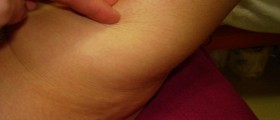
Lymphedema is the term which is used for the characteristic swelling that appears usually in only one arm or leg, but there are cases when lymphedema affects the both arms or both legs. Lymphedema occurs because the lymph, a clear fluid, cannot normally circulate through the lymphatic system due to some blockage in it, which has the typical swelling as the consequence. Depending on the accumulation of lymph in soft tissues, lymphedema can be mild and severe or primary and secondary. Primary lymphedema, which occurs due to the missing of the lymphatic channels which carry lymph, can be divided into three types: congenital – which occurs at birth, lymphedema praecox – which appears in puberty and usually in women, and lymphedema tarda – which occurs later in life. Secondary lymphedema happens because of some infection, or it occurs because of a tumor in the pelvis or groin in elderly people.
Symptoms
Just like for the every other disease, there are several symptoms for lymphedema as well. These symptoms can be noticed on either arm or leg. The visible swelling of a part, or of entire arm or leg, including even fingers or toes, is one of the warning signs that lymphedema may be present. Furthermore, the felling of tightness and aching in the affected limb and limited motion are also some of the symptoms that can appear. The person who suffers from this illness may also have recurring and frequent infections, as well as hardening and thickening of the skin of the leg or arm which is affected by lymphedema. In the case of severe lymphedema, even chills, fever, and toxicity are usual. Red lines may be seen all over the skin of the affected area, as well as the lymph nodes in the groin because they are enlarged when the patient suffers from secondary lymphedema.
Complications
It is recommended to avoid long standing, warm weather, and much eating when suffering from this disorder. Also, pregnancy and menstruation only worsen this condition. If the swelling prolongs, it is very important to visit the doctor. The specific treatment for lymphedema does not exist, but it is possible to ease and alleviate the swelling and pain. Exercises, wrapping the arm or leg, massage, pneumatic compression, and compression garments can be of great help for lymphedema. Herbs and nutritional supplements are recommended to be used along with these methods of treatment and they should not be taken alone. Surgery is done very infrequently, but if necessary in some extreme cases, it includes the removal of hypertrophied or obstructed lymph channels and resection of a great part of the skin and the tissues that are located beneath the skin.

















Your thoughts on this
Loading...